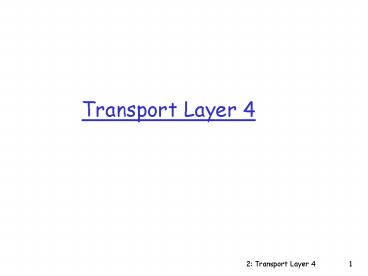Transport Layer 4 - PowerPoint PPT Presentation
1 / 9
Title:
Transport Layer 4
Description:
single bit indicating congestion (SNA, DECbit, TCP/IP ECN, ATM) ... loss event: timeout (Tahoe TCP) and/or or three duplicate ACKs (Reno TCP) ... – PowerPoint PPT presentation
Number of Views:184
Avg rating:3.0/5.0
Title: Transport Layer 4
1
Transport Layer 4
2
Approaches towards congestion control
Two broad approaches towards congestion control
- Network-assisted congestion control
- routers provide feedback to end systems
- single bit indicating congestion (SNA, DECbit,
TCP/IP ECN, ATM) - explicit rate sender should send at
- End-end congestion control
- no explicit feedback from network
- congestion inferred from end-system observed
loss, delay - approach taken by TCP
3
TCP Congestion Control
- end-end control (no network assistance)
- transmission rate limited by congestion window
size, Congwin, over segments
Congwin
- w segments, each with MSS bytes sent in one RTT
4
TCP congestion control
- two phases
- slow start
- congestion avoidance
- important variables
- Congwin
- threshold defines threshold between two slow
start phase, congestion control phase
- probing for usable bandwidth
- ideally transmit as fast as possible (Congwin as
large as possible) without loss - increase Congwin until loss (congestion)
- loss decrease Congwin, then begin probing
(increasing) again
5
TCP Slowstart
Host A
Host B
one segment
RTT
initialize Congwin 1 for (each segment ACKed)
Congwin until (loss event OR
CongWin gt threshold)
two segments
four segments
- exponential increase (per RTT) in window size
(not so slow!) - loss event timeout (Tahoe TCP) and/or or three
duplicate ACKs (Reno TCP)
6
TCP Congestion Avoidance
Congestion avoidance
/ slowstart is over / / Congwin gt
threshold / Until (loss event) every w
segments ACKed Congwin threshold
Congwin/2 Congwin 1 perform slowstart
1
1 TCP Reno skips slowstart (fast recovery)
after three duplicate ACKs
7
TCP Fairness
AIMD
- TCP congestion avoidance
- AIMD additive increase, multiplicative decrease
- increase window by 1 per RTT
- decrease window by factor of 2 on loss event
- Fairness goal if N TCP sessions share same
bottleneck link, each should get 1/N of link
capacity
TCP connection 1
bottleneck router capacity R
TCP connection 2
8
Why is TCP fair?
- Two competing sessions
- Additive increase gives slope of 1, as throughout
increases - multiplicative decrease decreases throughput
proportionally
R
equal bandwidth share
loss decrease window by factor of 2
congestion avoidance additive increase
Connection 2 throughput
loss decrease window by factor of 2
congestion avoidance additive increase
Connection 1 throughput
R
9
Summary
- principles behind transport layer services
- multiplexing/demultiplexing
- reliable data transfer
- flow control
- congestion control
- instantiation and implementation in the Internet
- UDP
- TCP
- Next
- leaving the network edge (application transport
layer) - into the network core































